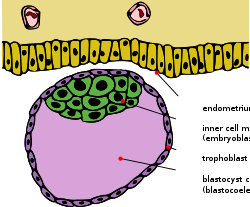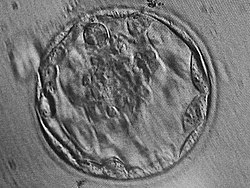User:NJSfour/sandbox
Blastocyst Edits[edit]
-Background/Summary/Context Blurb
The blastocyst is a structure formed in the early development of mammals. In humans, its formation begins 5 days after fertilization. It is preceded by the morula. It possesses an inner cell mass (ICM), or embryoblast, which subsequently forms the embryo, and an outer layer of cells, or trophoblast, surrounding the inner cell mass and a fluid-filled cavity known as the blastocoele. The human blastocyst comprises 70-100 cells.
Developmental cycle[edit]
The blastocyst develops from the morula, an early embryo made of 16 undifferentiated cells, through cavitation. Trophoblast cells secrete fluid inside the embryo. This forms an internal fluid-filled cavity called the blastocoel. The cells differentiate into two types, an inner cell mass (ICM) growing on the interior of the blastocele and trophoblast cells growing on the exterior. The animal pole refers to the side of the blastocyst where the ICM resides, while the vegetal pole is on the opposite side. The trophoblast cells pump sodium ions into the blastocoel, which causes water to enter through osmosis. After 24 to 48 hours, the zona pellucida breaches, referred to as hatching. This removes the constraint on the physical size of the embryonic mass and allows for implantation into the uterine wall. Once bound to the extracellular matrix of the endometrium, trophoblast cells secrete enzymes to embed the blastocyst into the uterine wall.
Implantation in the uterine wall allows for the next step in embryogenesis, Gastrulation which includes formation of the placenta from trophoblastic cells and differentiation of ICM into amniotic cavity and epiblast.
Structure[edit]
The blastocyst is made up of blastomere cells and the blastocoel
There are two types of blastomere cells:
- the inner cell mass, also known as the "embryoblast," which gives rise to all later structures of the adult organism
- the trophoblast, a layer of cells forming the outer ring of the blastocyst that combine with the maternal endometrium to form the placenta
The trophoblast cells also secrete the fluids to make the blastocoel
The blastocoel fluid cavity contains amino acids, growth factors, and other necessary molecules for cellular differentiation.
Cell Specification
Multiple processes control cell lineage specification in the blastocyst to produce the trophectoderm, epiblast, and primitive endoderm. These processes include: gene expression, cell signaling, cell-cell contact and positional relationships, and epigenetics.
Once the ICM has been established within the blastocyst, this cell mass prepares for further specification into the epiblast and primitive endoderm. This process of specification is determined by Fibroblast Growth Factor (FGF) signaling which generates a MAP kinase pathway to alter cellular genomes. These genomic alterations allow for the progressive specification of both epiblast and primitive endoderm lineages at the end of the blastocyst phase of development preceding gastrulation.
Trophoblasts express integrin on their cell surfaces which allow for adhesion to the extracellular matrix of the uterine wall. This interaction allows for implantation and also triggers further specification into the 3 different cell types, preparing the blastocyst for gastrulation.
Clinical Implications[edit]
Blastocyst In Vitro Fertilization[edit]
Blastocysts have played a major role in the advancement of In vitro fertilization (IVF). In-vitro fertilization is an alternative to traditional in vivo fertilization for fertilizing an egg with sperm and implanting that embryo into a female’s womb. For many years the embryo was inserted into the fallopian tube two to three days after fertilization. However at this stage of development it is very difficult to predict which embryos will develop best, and several embryos were typically implanted. Several implanted embryos helped to guarantee that there would be a developing fetus but it also led to the development of multiple fetuses. This was a major problem and drawback for using embryos to IVF.
A recent breakthrough in in vitro fertilization is the use of blastocysts. A blastocyst would be implanted five to six days after the eggs had been fertilized. After five or six days it is much easier to determine which embryos will result in healthy live births. Knowing which embryos will succeed allows just two or three blastocysts to be implanted, cutting down on multiple births. Now that the nutrient sources for embryonic and blastocyst development has been determined, it is much easier to give embryos the correct nutrients in order to sustain them into the blastocyst phase. Blastocyst implanting through in vitro fertilization is a painless procedure in which a catheter is inserted into the vagina, guided through the service via ultrasound, and the blastocysts are inserted into the womb.
Blastocysts also offer an advantage because they can be used to genetically test the cells to check for genomic problems. There are enough cells in a blastocyst that a few cells are able to be removed without disturbing the developing blastocyst. These cells can be tested for genetic defects using immunofluorescent tags. .
Blastocyst in Art[edit]
In 1907 Gustav Klimt painted Danae depicting Zeus, disguised as golden coins, impregnating Danae. On the fabric of the sheets in the painting, however there appears to be what looks like golden blastocysts. The blastocysts represent life and growth. It is hypothesized that Klimt had this very early knowledge of the blastocysts because of his association with anatomist, Emil Zuckerkandl. Zuckerlandl and Klimt frequented the same salons and Klimt was probably able to know of the microscopic cell mass because of this association.
| Blastocyst | |
|---|---|
 Blastocyst just before implantation | |
 A human blastocyst, 5 days after fertilisation | |
| Details | |
| Carnegie stage | 3 |
| Days | 8 |
| Precursor | Morula |
| Gives rise to | Gastrula and inner cell mass |
| Identifiers | |
| Latin | Blastocystis |
| Anatomical terminology | |

This article includes a list of references, related reading, or external links, but its sources remain unclear because it lacks inline citations. (April 2012) |
References[edit]
![]() This article incorporates text in the public domain from the 20th edition of Gray's Anatomy (1918)
This article incorporates text in the public domain from the 20th edition of Gray's Anatomy (1918)

